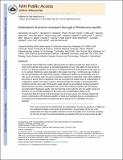Retardation of arsenic transport through a Pleistocene aquifer
Author(s)
van Geen, Alexander; Bostick, Benjamín C.; Thi Kim Trang, Pham; Lan, Vi Mai; Mai, Nguyen-Ngoc; Manh, Phu Dao; Viet, Pham Hung; Radloff, Kathleen; Aziz, Zahid; Mey, Jacob L.; Stahl, Mason; Harvey, Charles F.; Oates, Peter; Weinman, Beth; Stengel, Caroline; Frei, Felix; Kipfer, Rolf; Berg, Michael; ... Show more Show less
DownloadHarvey_Retardation of.pdf (1.316Mb)
OPEN_ACCESS_POLICY
Open Access Policy
Creative Commons Attribution-Noncommercial-Share Alike
Terms of use
Metadata
Show full item recordAbstract
Groundwater drawn daily from shallow alluvial sands by millions of wells over large areas of south and southeast Asia exposes an estimated population of over a hundred million people to toxic levels of arsenic1. Holocene aquifers are the source of widespread arsenic poisoning across the region2, 3. In contrast, Pleistocene sands deposited in this region more than 12,000 years ago mostly do not host groundwater with high levels of arsenic. Pleistocene aquifers are increasingly used as a safe source of drinking water4 and it is therefore important to understand under what conditions low levels of arsenic can be maintained. Here we reconstruct the initial phase of contamination of a Pleistocene aquifer near Hanoi, Vietnam. We demonstrate that changes in groundwater flow conditions and the redox state of the aquifer sands induced by groundwater pumping caused the lateral intrusion of arsenic contamination more than 120 metres from a Holocene aquifer into a previously uncontaminated Pleistocene aquifer. We also find that arsenic adsorbs onto the aquifer sands and that there is a 16–20-fold retardation in the extent of the contamination relative to the reconstructed lateral movement of groundwater over the same period. Our findings suggest that arsenic contamination of Pleistocene aquifers in south and southeast Asia as a consequence of increasing levels of groundwater pumping may have been delayed by the retardation of arsenic transport.
Date issued
2013-09Department
Massachusetts Institute of Technology. Department of Civil and Environmental EngineeringJournal
Nature
Publisher
Nature Publishing Group
Citation
van Green, Alexander, Benjamim C. Bostick, Pham Thi Kim Trang, Vi Mai Lan et al. "Retardation of arsenic transport through a Pleistocene aquifer." Nature 501, 204–207 (12 September 2013).
Version: Author's final manuscript
ISSN
0028-0836
1476-4687